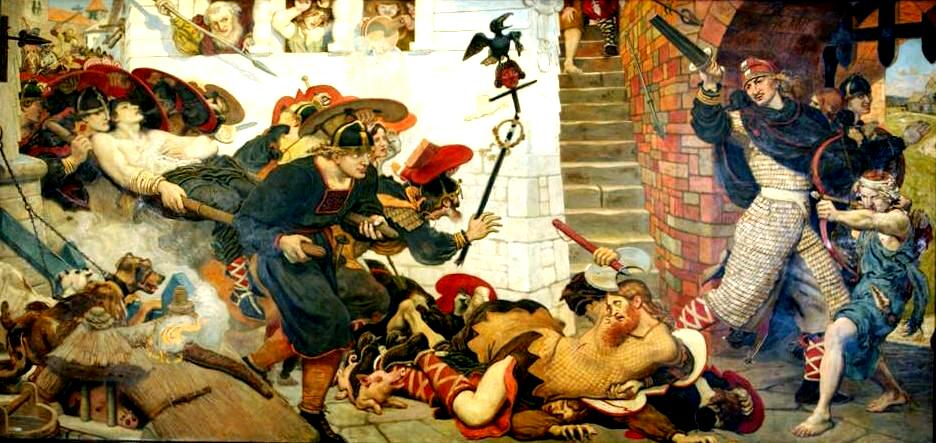
English History: Saxon-Danish Struggle for England (9th-11th centuries)

Figure 1.--The Anglo-Saxon kingdoms of Northumbria, Mercia and Wessex struggled for control over North West England (6th-10th cnturies). Edwin of Northumbria may have sacked Manchester (620). The Danes may have sacked it (870). The Anglo Saxon Chronicle describe how Edward the Elder sent men "to Mameceaster, in Northumbria, to repair and man it", probbly meaning the old Roman fort (919). The Danes appear to have controlled the area for some time. This mural depicts 'The Expulsion of the Danes from Manchester'. We are not sure just when. The Danes carry their leader on a stretcher. This is one of the Manchester Murals by Ford Madox Brown painted for the Manchester Town Hall.
|
|
The Vikings raided the eastern North Sea coast of England for decades when the weather improved every summer. Finally they began establishing permanent settlements. And the struggle for the land began. Out of that struugle would come England. The first Viking winter settlement was on the sle of Sheppery in Kent (854). It was not only raiding that attracted the Vikings. Once plundered, thee was not much left to seize by raiding. Scandanavia had very limited farmland, especially Mountneous Norway. The land was better in Denmark, but it was a small peinsula. England offered large areas of excelent farm land. And at the time agriculture was the primary source of wealth. The sons of Ragnar - Ivarr the Boneless, Halfdan, and Ubbi led a Great Army to Englnd. They advanced across Mercia and Northumbria. The divide Anglo-Saxon kingdoms weakened by raiding could not effectively oppose them. The Great army next moved south into East Anglia (870). They killed King Edmund and sacked the abbey at Peterborough. This left the Danes in control of much of the north and east. And they threatend to conquer all of the south and west. Only one English king has the honor of being call great--Alfred the Great. Thanks to Alfred, Wessex survived the Viking/Danish incursions. The Great Army terrorized the Anglo-Saxons for a decade. Guthrum came close to conqueing Wessex. Alfred amassed a Saxon Army and defeated the Danes at Eddington (878). The Danes were not destroyed but they were forced to make peace with Alfred. Guthrum retreated into East Anglia with an agreement that the England wouuld be divided. The Treaty of Wedmore established the boundary of the Danelaw as, "up the Thames as far as the river Lea, then up the Lea to its source, and then straight to Bedford, and then up the Ouse to Watling Street'. Alfred died with a divided Britain, but with Wessex secure. The Danes were by then also firmly established. All of the kingdoms of East Anglia and Northumbria were partof the Dane Law. ercia appears to have been a ravaged land, with Ealdormen being set up by Wessex only to be undone by the Danes. Alfred's descendents managed to win back large aeas of southern and central England from the Vikings, generally referred to as the Danes. It is at this time that England emerges in European history, although it was a badly divided country between the Anglo-Saxon areas and the Dane Law, not to mention the Romo-Britains (Welsh) in the west and Scotts in the north. This period is of considerable importance becuse much of the country had not yet been feudalized, and the non-Feudal insitutioins of the Saxons and Danes are a factor in England even after the Norman conquest developing differently than more fully feudal Europe. The Saxon monarchy gradually gained in strength and attempted to wipe out the Danes. A Danish dynasty seized control of England at the same time that William Duke of Normandy began to plan to seize the kingdom.
CIH

'
Navigate the Boys' Historical Clothing Web Site:
[Return to the Main English history page]
[Return to the Main Anglo-Saxon page ]
[Return to the Main English Viking invasion page]
[About Us]
[Introduction]
[Biographies]
[Chronology]
[Climatology]
[Clothing]
[Disease and Health]
[Economics]
[Freedom]
[Geography]
[History]
[Human Nature]
[Ideology]
[Law]
[Nationalism]
[Presidents]
[Religion]
[Royalty]
[Science]
[Social Class]
[Bibliographies]
[Contributions]
[FAQs]
[Glossaries]
[Images]
[Links]
[Registration]
[Tools]
[Children in History Home]
Created: 4:28 AM 1/15/2018
Last updated: 4:28 AM 1/15/2018



